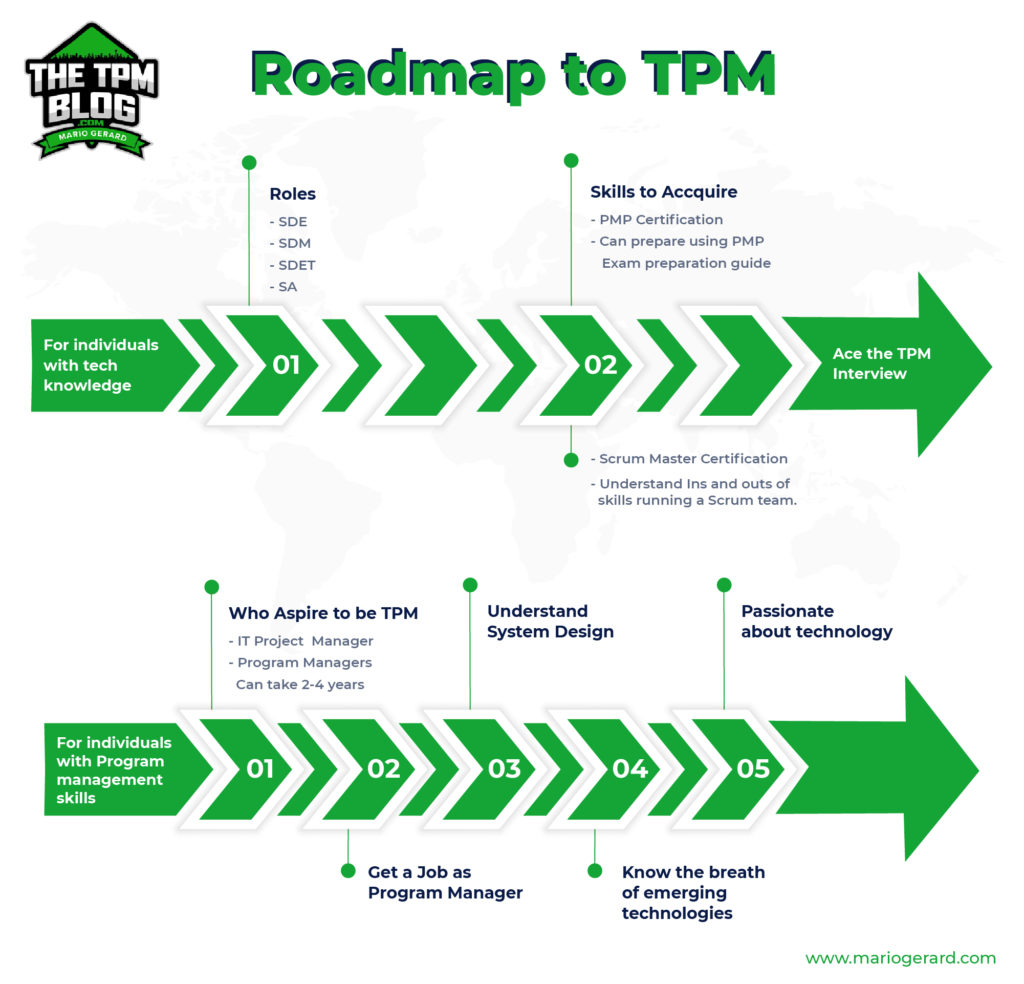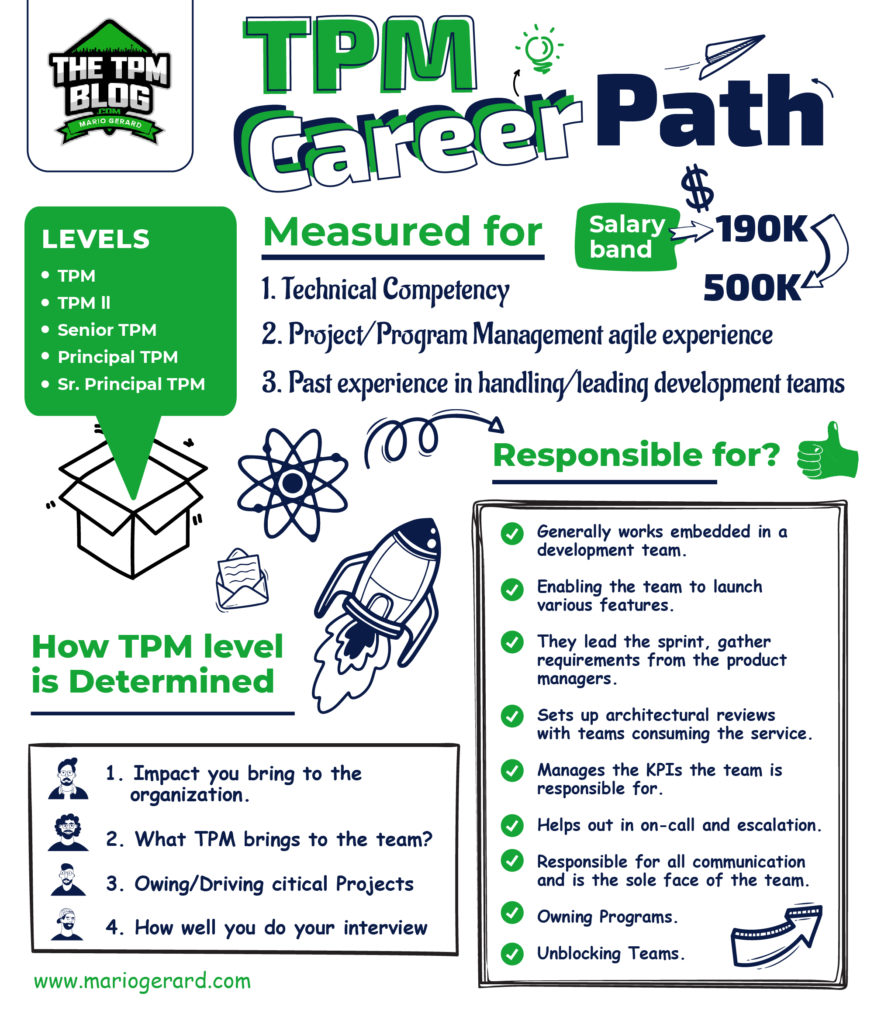Last updated on January 2nd, 2024 at 01:04 pm
What is the role of a Technical Program Manager (TPM)?” A TPM enables tech organizations to achieve their goals faster. This is done by working with all the stakeholders and upstream and downstream teams. TPMs drive programs to completion in a quick and effective manner.
How to become a technical program manager is one of the most common questions I get asked. The answer is quite varied as it depends on what you as an individual stand and what your current skill set and role are. I do have quite a few articles on similar topics:-
- Udemy course for TPMs by Mario Gerard
- Episode 1: TPM 101 – The Technical Program Management Podcast with Mario Gerard
- TPM Interview: With Alessandro Catorcini
- Interview Questions For A Technical Program Manager (TPM)
Getting a Certification
You need to understand the two primary areas of competency for TPMs
- Technical Knowledge
- Program and Project Management.
For individuals with a Technical Acumen
There are some roles that have a high emphasis on an individual’s technical ability like – Software Developers (SDE), Software Development Managers (SDM), Software Development Test Engineers (SDET), Solution Architects (SA) these are a few of the individuals who could become a Technical Program Manager if they can pick up the project/program management skills.
To pick up the project or program management skills they would ideally need to do a PMP Certification you can do the certification if you prepare using the PMP Exam Prep Guide. Though you don’t see a lot of jobs explicitly asking for a PMP certification I can guarantee you that it will help you on the job or while you interview for the role.
The second one is to do the ScrumMaster certification. This helps in understanding the ins and out of running a Scrum team. You might have in the past been part of a scrum team, but running an effective Scrum team is a whole different story.
Well, now that I have given some information on what you need to learn I would like to throw a word of caution. A TPM role is unique, it requires you to be tolerant of the various needs and attitudes of people. You as an individual need to understand that a TPM is there primarily to enable the smooth sailing of the program you are responsible for. The buck stops with you which means that you are the single individual who is responsible to make an initiative successful and you would need to do whatever it takes to make that happen.
A lot of devs and SDETs who make this transition fail to realize that a TPMs role is tough and requires a lot of behind-the-scenes work. You need to be a people person who thrives in an environment that is always dealing with ambiguity. It’s not everyone’s cup of tea!
From a transition perspective, this is a relatively easy transition. I say so because its a relatively easy job to learn Project and Program Management and a much tougher route to learn the technical aspects of things. It is important to note however that Project management is said to be an art more than a science and the reason for this is some things cannot be taught it is a rare skill that few acquire after years of experience.
Related read:
Technical Program Manager Certification
Certifications – To Dos or Not to Dos
Individuals who have the Program Management Skill
There are a LOT of people who are project managers, IT project managers, Program Managers who aspire to be Technical Program Managers. The Technical Program Manager Career Path is a lot harder for individuals who have little or no technical exposure. It is not impossible but it’s a long road. And when I say it’s a long road I mean it requires dedication and a lot of learning maybe over a period of 2-4 years at the very least.
The reason for this is that there are so many nuances and technologies to understand to be an effective TPM. Technical Program Manager Career Path comes with learning a great breadth of technologies. You can find more information in this blog post detailing TPM Interview Questions. Even learning all the technologies would not be enough because you need to know how they all fit together. The only way to do this is to get a job as a Project or Program Manager in a tech organization and slowly shadow a TPM to learn about the breadth of technologies, various pieces involved and understand how they fit together.
The second and most important thing to remember is a TPM needs to be passionate about technology. The reason behind this is that technologies change at a rapid rate, every month or two there is something new. There is a brand new trend every 4 to 6 months. And the TPM needs to know the breath of these emerging technologies, how they fit together and how they are different and what problem each of them solve.
Technical Program Manager Career Path
Every organization is different and the levels may vary. But in general, you have the below levels:-
- Technical Program Manager
- Technical Program Manager II
- Technical Program Manager III or Senior Technical Program Manager
- Principal Technical Program Manager
- Sr Principal Technical Program Manager
The above is if you would like to be an individual contributor all the way. I will detail below what the people management rote looks like. But before we go there let me shed some light on what the various levels mean.
In my opinion, the levels are determined by how well one performs at the interview. Every organization has a certain bar or call it a yardstick they measure a Technical Program Manager against. In general, you are measured for:-
- Technical Competency
- Project / Program Management & Agile Experience
- Past Experience in Handling & Leading Development Teams
Depending on how you as a Technical Program Manager perform against the organizations’ yardstick you are assigned a level and the respective salary band for that role.
If you are already at an organization and you are looking to move up the best thing to do is to talk to your manager about how you are doing at your current level and what the expectations for the move up would be.
How a Technical Program Manager Career Path Levels Are Determined:-
- IMPACT – The level of impact though hard to measure is the main yardstick. Look around you, look at people a level up or at your same level and assess the impact of the programs they own and run.
- The Technical Program Manager brings to the Team and the organization as a whole. Understand the holistic approach of running a program.
- Owning and driving critical and high visibility and high-risk Projects / Programs.
Though you might feel that the above bullets are ambiguous let me tell you that really are not. Let me compare a Technical Program Manager vs a Principal Technical Program Manager.
A Technical Program Manager (TPM) is responsible for –
- Generally works embedded in a development team
- Enabling the team to launch various features.
- He leads the sprints, gathers requirements from the product managers.
- Sets up architectural reviews with teams consuming the service.
- Manages the KPIs the team is responsible for.
- Helps out in on-call and escalation.
- Responsible for all communication and is the sole face of the team
A Principal Technical Program Manager, on the other hand, does all of the above and also :-
- Takes on high risk and high visibility programs
- Is able to handle programs that touch a multitude of teams
- Handles Cross team dependencies well.
- Is the face of an entire business unit.
I hope that gives you a sense of the differences between the levels of a Technical Program Manager.
Let’s move on to the People manager, Principal Technical Program Managers. After the Level II TPM or a Senior TPM you have an option to either be an individual contributor as a Principal TPM or to become a Manager/Director of Principal Technical Program Managers. This role again has levels I to V but has TPMs reporting to them.
In many organizations, you have one Manager/Director TPMs for one business unit. He/She is responsible for all the delivery across all the programs for that specific business unit. The people managers are generally there so that there is cohesion between all the TPMs working on that team. Often teams like this need to constantly exchange information and are reliant on each other to function in excellence, which is why a unified reporting structure makes sense.
One other outcome of the various levels are the salaries an individual receives as he/ she moves up. You can get a good picture of the various salaries here – Technical Program Manager (TPM) Salary Analysis and Salary Analysis of Senior Program Managers.
And Don’t forget to check out my Udemy course for TPMs !














